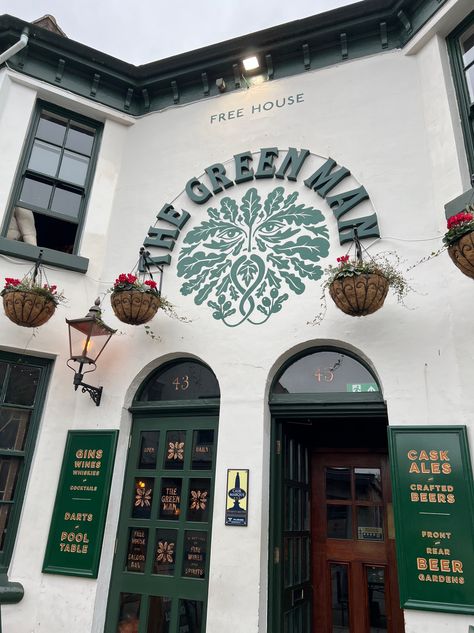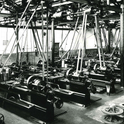Ah, the May Day bank holiday weekend, when two quintessentially English pastimes come together: drinking alcohol in spring sunshine and celebrating our curious, folklorish heritage of maypoles, ‘obby ‘osses and Morris dancing.
And the two collide most satisfactorily in what is by no means the most common of pub names but surely the most mysterious and alluring: The Green Man.
According to The Campaign for Real Ale (Camra), there are currently 72 pubs open in the UK bearing the name The Green Man. Most of them are venerable, and almost all feature a variation on the same pub sign: a “foliate head”, formed of vegetation and leaves, but representing a male human.
The pubs are scattered around the country, but seem to proliferate in the south and generally rural areas. The locations on the Camra register speak of a pastoral England (even if they aren’t, necessarily, any more): Shepreth and Thriplow, Great Offley and Long Itchington, Toot Hill and Kings Stag.
But who—or what—is this figure, peering from the foliage? William Anderson writes in his book The Green Man (1990): “The Green Man signifies irrepressible life. Once he has come into your awareness, you will find him speaking to you wherever you go. He is an image from the depths of prehistory, he appears and seems to die and then comes again after long forgettings at many periods in the last 2,000 years. In his origins he is much older than our Christian era. In all his appearances he is a symbol of renewal and rebirth.”
Anderson’s book doesn’t concern itself with pubs, unfortunately, but rather “to show that his reappearance today in art and as a symbol of environmental movements is of the profoundest significance for humanity”.
In the 35 years since Anderson wrote his book, the idea of the Green Man has indeed bloomed. Since 2003, a music festival of the same name has been held in the Brecon Beacons in Wales, every August. In a society increasingly aware of climate change, the environment and how humanity is influencing both, the Green Man has become almost a poster boy for reconnecting with nature.
“I think this feeds into where he is really important,” says folklorist Icy Sedgwick, “and that’s through the way people have embraced the concept of the Green Man in relation to nature—we have a greater environmental awareness now, and if the idea of a nature god inspires people to take better care of the natural spaces near them, whether that’s campaigning for cleaner rivers, taking rubbish home with them or being watchful for wild fires, then that can only be a good thing.”
The Green Man is a collection of ideas
The Green Man, though, is an ambiguous and somewhat complicated figure. He isn’t necessarily an actual entity or god, but seemingly a collection of ideas. In his 1969 book, Introduction to Inn Signs, Eric R Delderfield says this: “Green Man: A common sign in some counties, it represented the forester, and was sometimes meant to portray Robin Hood. Often, too, it sprang from folklore. Another form of the sign is Jack-in-the-Green, a prominent figure in pagan revels.”
Most Green Man pubs are indeed located in the country, where you might expect such pagan revels to hold sway. But they do appear in more urban—even inner-city—areas. Bradford in West Yorkshire once had a Green Man in the Undercliffe area. The building as a pub dated back to 1796, when it was called The Rifleman, changing its name sometime in the early 1800s.
Pub historian Paul Jennings doesn’t quite know why the name changed. “You would expect Green Man pubs to be in more rural areas, as pub names often reflected local industries or interests, that sort of thing. Curiously, there was also a pub very close to the old Green Man called the Robin Hood.”
In fact, the term “Green Man” is thought to have only permeated public consciousness in 1939, when Lady Raglan, writing in the journal Folklore, discussed the proliferation of foliate heads on churches and how this folklorish figure fitted into Christian ideology. Her article crystallised the idea of the Green Man into something it previously had never been.
Sedgwick says: “People insist the Green Man was an ancient nature god, hiding among the carvings as a representation of paganism, but the truth is less exciting. We can find examples of foliate heads in art right back into ancient Rome. When they appear in churches from the Norman and Gothic period, they’re actually a form of ‘grotesque’, and England imported the design from France in the 12th century.
“Lady Raglan described them as a representation of ‘the Green Man’ in 1939 and invented a tradition in which the Jack-in-the-Green took part in spring fertility rituals. Witchcraft authors went on to describe the Green Man as a wild nature god or a spirit of the wild wood; elsewhere, writers asserted all sorts, including the idea that when a tree was cut down its spirit needed to be provided another home so it wouldn’t be offended, and the Green Man served this purpose.”
Herein lies another mystery, though. If Lady Raglan is credited with coining the term Green Man, why did so many pubs bear the name for decades, even centuries, previously? Take The Green Man in Colne, Huntingdon. According to Camra (which named it Huntingdonshire rural pub of the year in 2020), it dates back to the 17th century.
Charley Orpwood is the landlady there, and says the pub definitely has a certain vibe about it. So much so that it was recently visited by paranormal investigators. So it’s haunted? “Oh, definitely!” says Orpwood. “We have the most bizarre goings on, things falling off shelves, taps turning on and off when there’s nobody there. The paranormal investigators believe that there is a child and he likes the kitchen area. We’re not sure why he likes the kitchen area, but he’s the one that turns the taps on and off because he finds it really funny.”
Before it was a pub, the building was a courthouse, says Orpwood, and had a gallows out the front for the dispensing of summary justice. The pub leans into its name as well; last year, they held an event for children, with one member of staff making Green Man masks. “She had a story about the Green Man and, to be honest, it was all completely made up,” confesses Orpwood. “It was something to entertain kids for an afternoon.”
That said, all stories about the Green Man seem to have been made up. Sedgwick adds: “I think the Green Man is one of those figures that really appeals to people, and I still see people confidently asserting that he’s this ancient nature god lurking in churches as a sign of the mason’s pagan leanings. But this is where folklore is so fascinating.”
He’s certainly captured the imagination of writers and filmmakers. In the classic folk-horror film The Wicker Man (1973), the pub on the isolated, pagan island of Summerisle, where Edward Woodward’s unfortunate policeman Neil Howie stays while trying to find a missing girl (and fend off the attentions of Britt Ekland’s landlord’s daughter Willow) is, of course, called The Green Man Inn (though, in reality, the interiors were shot in the Ellangowan Hotel on the mainland and the exteriors in the small Scottish town of Gatehouse of Fleet).
Kingsley Amis’s 1969 novel The Green Man is set in the titular fictional pub in Hertfordshire, a ghost story later filmed by the BBC in 1990, starring Albert Finney as the philandering, hard-drinking Maurice Allington, drawn into a dark, nightmarish, occult world.
And more prosaic, perhaps, the real-life Green Man on Liverpool’s Vauxhall Road—now demolished, like many hostelries in the embattled pub business—was the location for one of the many memorable scenes in Alan Bleasdale’s classic 1982 BBC series Boys from the Blackstuff. The pub was the stamping ground of the psychopathic finger-crusher Shake Hands, who eventually met his match in Bernard Hill’s bleak and broken Yosser Hughes.
Let’s stay in Liverpool, though, for another Green Man pub, this one on busy, bohemian Lark Lane on the edge of the city’s Sefton Park. It certainly looks the part, with its vast Green Man image plastered across the white frontage, and its dark corners and exposed beams—some of them bearing quotes from Kingsley Amis’s Green Man. Lark Lane’s Green Man isn’t as old as it might appear, though; it only opened in December 2023, making it the youngest Green Man in the country.
Part of the pub empire of entrepreneur Rob Gutmann, the Green Man was previously a bar and restaurant called The Ink on the Wall. When Gutmann bought it, he was inspired to change the name after reading the Amis novel. The look of it fell to Matt Lewis, creative director of the Chester-based Stride design agency. Lewis pored over old visual representations of the Green Man and fell into a rabbit hole of research.
“I just wanted something quite bold and upfront,” says Lewis. “It was very much taking a straight-on approach with it and incorporating leaves to form the face. Those leaves also flow through to the beer mats and cocktail menus. We got a signwriter to paint the sign on the wall because we didn’t want a plastic or metal sign to get the look.
“Lark Lane is a bit of a cool area on the outskirts of Liverpool and it’s dominated by Sefton Park, which I feel is a nice connection as it’s very green, there are trees that are hundreds of years old there, the streets around it are lined with trees. It feels fitting to have what’s effectively a new pub having this connection to something so old, and all the nature around it.”
If you have the weather, and you’re lucky enough to live near a Green Man pub, then hopefully you might enjoy your bank holiday celebrations with this most curious of folklore figures… and perhaps the next time you pass a Green Man, it might make you think.
“Even if the Green Man isn’t this god, he makes a good gateway into nature-based folklore for anyone who’s interested,” says Sedgwick. “He’s also a good reminder of the importance to dig into folkloric motifs beyond what you might see on an Instagram graphic.”














